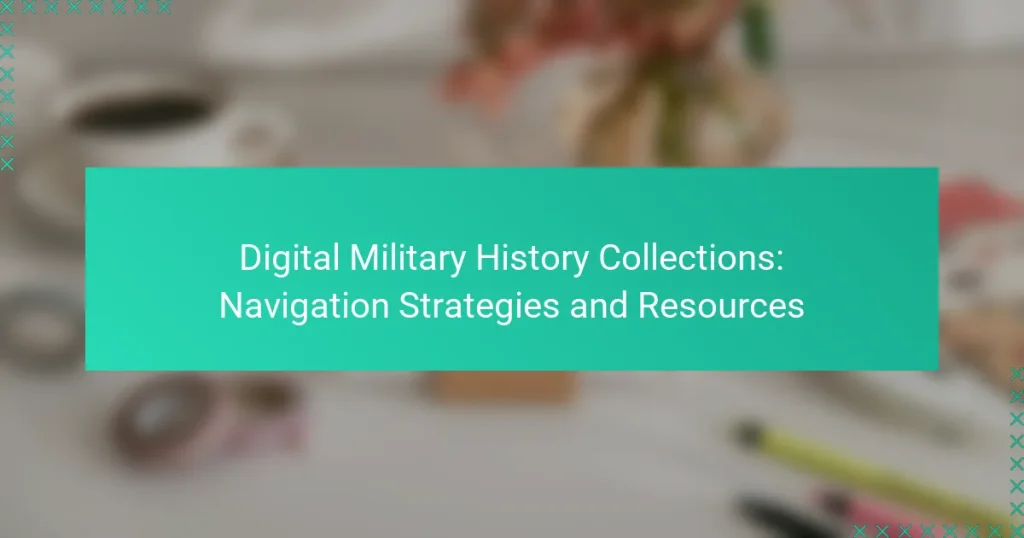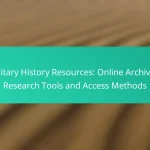Digital military history collections are invaluable resources for researchers, educators, and enthusiasts alike, offering access to a wealth of documents, photographs, and multimedia that capture significant military events and experiences. To navigate these collections effectively, it is essential to utilize advanced search features, leverage metadata, and apply filters for specific time periods, enhancing the efficiency of your research. Additionally, various tools such as digital archives and interactive timelines further enrich the exploration of military history.
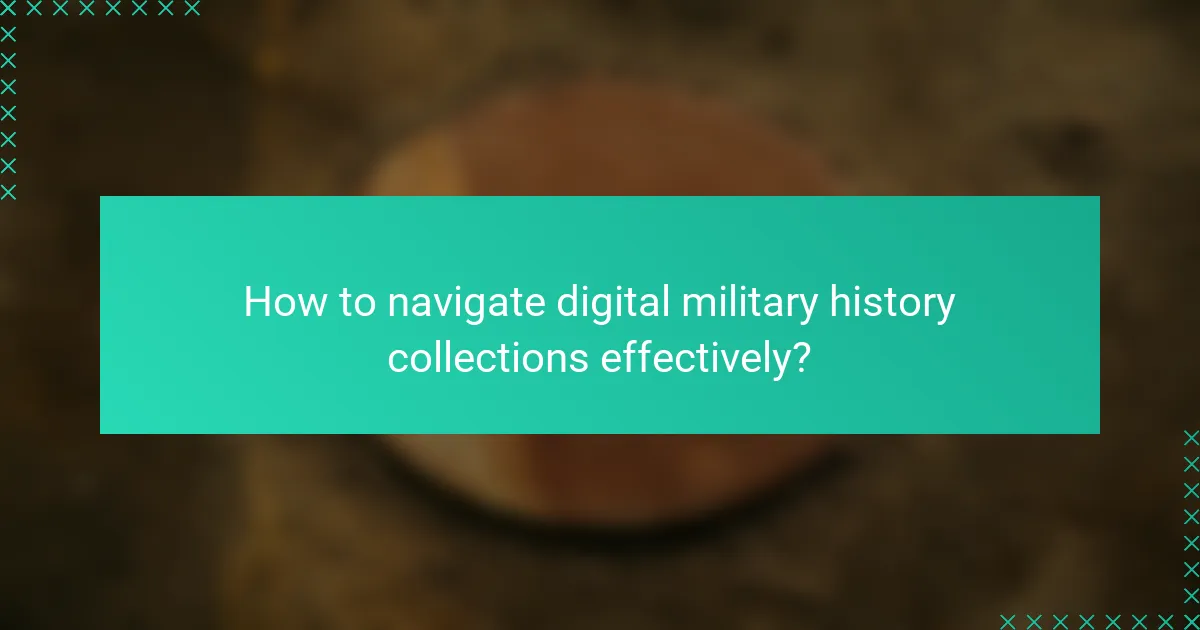
How to navigate digital military history collections effectively?
To navigate digital military history collections effectively, focus on utilizing advanced search features, leveraging metadata, and employing filters for specific time periods. These strategies enhance your ability to find relevant materials quickly and efficiently.
Utilizing advanced search features
Advanced search features allow users to refine their queries by specifying criteria such as keywords, document types, and publication dates. For instance, using Boolean operators like AND, OR, and NOT can significantly narrow down search results to the most relevant items.
Many digital collections also offer options to search within specific fields, such as titles or authors, which can lead to more precise results. Familiarizing yourself with these features can save time and improve the quality of your findings.
Leveraging metadata for better results
Metadata provides essential information about each item in a collection, including author, date, subject, and format. By understanding how to read and utilize metadata, you can quickly assess the relevance of documents to your research.
Look for collections that provide detailed metadata descriptions, as they often include tags and categories that can guide your search. This can help you discover related materials that you might not find through a standard search.
Employing filters for specific time periods
Filters for specific time periods enable you to focus your research on particular eras, which is crucial in military history. Many digital collections allow users to set date ranges, helping to eliminate irrelevant documents from your results.
When using filters, consider the historical context of your research. For example, if you’re studying World War II, set your filters to the 1930s and 1940s to find the most pertinent information. This targeted approach can lead to more meaningful insights and connections in your research.

What are the best digital military history collections available?
The best digital military history collections provide extensive resources for researchers, educators, and enthusiasts. These collections offer access to documents, photographs, and multimedia that illuminate military events and experiences across various time periods.
National Archives Digital Collections
The National Archives offers a vast array of digital military history collections, including records from the Revolutionary War to modern conflicts. Users can access documents, maps, and photographs that are essential for understanding military history in the United States.
To navigate these resources effectively, start by using the online catalog to search for specific conflicts or units. Consider utilizing filters for dates and types of materials to streamline your research. Be aware that some documents may require additional permissions for access.
Library of Congress Military History Resources
The Library of Congress provides a rich collection of military history resources, featuring primary source materials, historical documents, and multimedia content. This collection covers a wide range of topics, from the Civil War to contemporary military operations.
When exploring these resources, take advantage of the Library’s digital collections portal, which allows for keyword searches and browsing by topic. Utilize the “American Memory” section for curated collections that highlight significant military events and figures. Keep in mind that some resources may be limited to in-library use.
Imperial War Museum Collections
The Imperial War Museum (IWM) houses extensive digital collections focused on the impact of war on society, featuring photographs, personal stories, and artifacts from various conflicts. Their collections span both World Wars and subsequent military engagements.
To make the most of the IWM’s offerings, use their online search tool to find specific items or themes. The museum also provides educational resources that can enhance understanding of military history. Note that some collections may have restrictions based on copyright or preservation status.
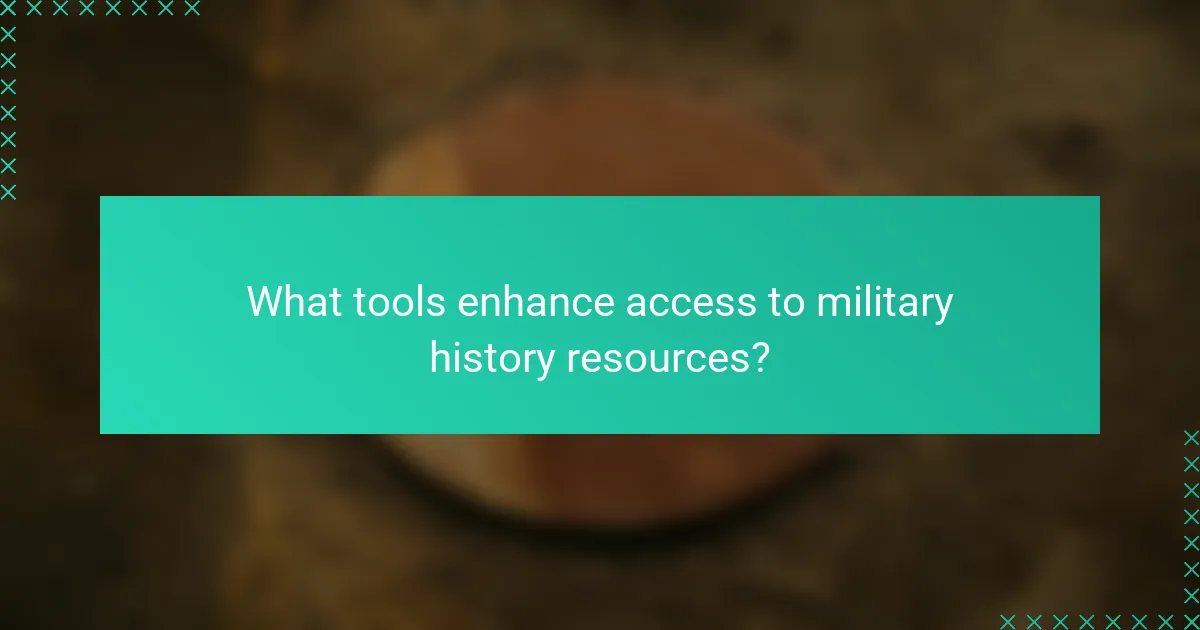
What tools enhance access to military history resources?
Several tools significantly improve access to military history resources, making research more efficient and comprehensive. Digital archives, specialized research databases, and interactive tools like timelines and maps provide diverse ways to explore military history.
Digital archives platforms
Digital archives platforms serve as repositories for a wide range of military documents, photographs, and artifacts. These platforms often include collections from various institutions, allowing users to access primary sources that are crucial for in-depth research.
Examples of notable digital archives include the National Archives in the United States and Europeana, which aggregates content from multiple European institutions. When using these platforms, consider the search functionalities and filters available to streamline your research process.
Research databases like JSTOR
Research databases such as JSTOR provide access to scholarly articles, books, and primary sources related to military history. These databases are invaluable for academic research, offering peer-reviewed content that enhances the credibility of your findings.
When utilizing JSTOR, take advantage of advanced search options to narrow down results by subject, publication date, or type of document. Many institutions offer free access to these databases, so check if your library provides a subscription.
Interactive timelines and maps
Interactive timelines and maps are effective tools for visualizing military history events and movements. They allow users to see the chronological progression of conflicts and the geographical context of military actions, making complex histories more digestible.
Platforms like the World War I and II interactive maps provide engaging ways to explore battles and troop movements. When using these tools, look for features that allow you to filter by specific events or regions to enhance your understanding of particular conflicts.
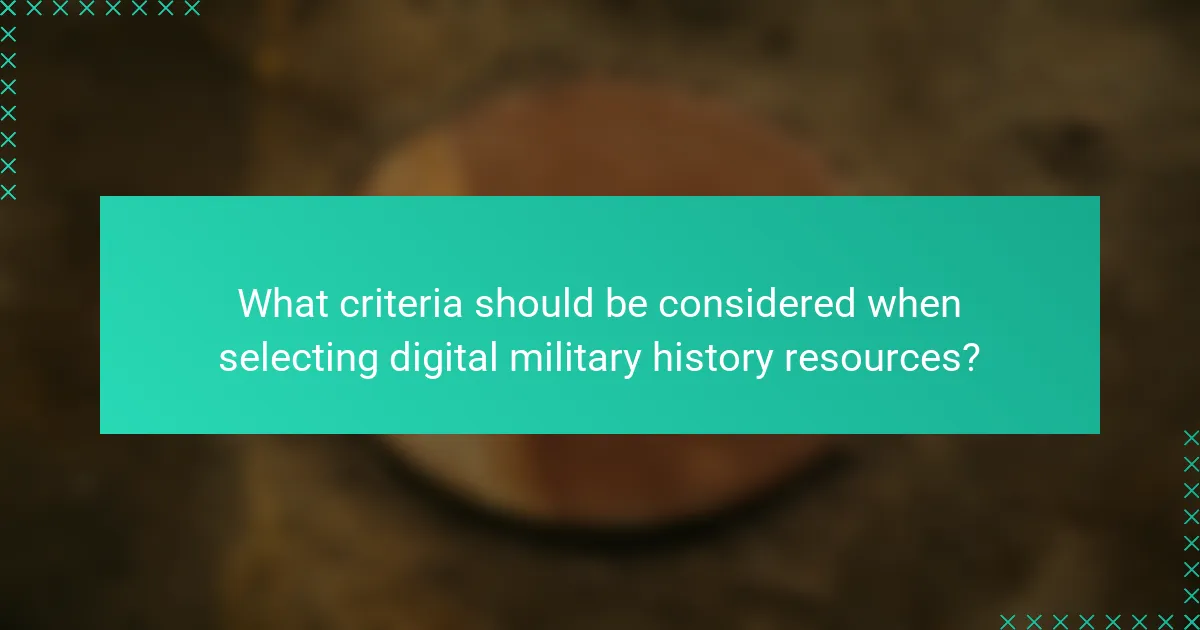
What criteria should be considered when selecting digital military history resources?
When selecting digital military history resources, consider the credibility of the source, the scope of the collection, and the accessibility features available. These criteria help ensure that the resources are reliable, comprehensive, and user-friendly.
Credibility of the source
Assessing the credibility of the source is crucial for ensuring the reliability of the information. Look for resources published by reputable institutions, such as universities, government agencies, or established historical societies. Peer-reviewed articles and publications from recognized experts in military history also enhance credibility.
Check for citations and references within the resource. A well-documented source typically indicates thorough research and reliability. Be cautious of personal blogs or unverified websites, as they may lack the necessary scholarly rigor.
Scope of the collection
The scope of the collection refers to the breadth and depth of the materials available. Consider whether the collection covers specific conflicts, time periods, or geographical regions of interest. A comprehensive collection should include various types of materials, such as documents, photographs, maps, and oral histories.
Evaluate the collection’s focus. Some resources may specialize in particular aspects of military history, such as strategy, technology, or social impacts. Ensure that the collection aligns with your research needs and interests to maximize its usefulness.
Accessibility features
Accessibility features are essential for ensuring that all users can effectively utilize digital military history resources. Look for platforms that offer user-friendly navigation, search functions, and clear categorization of materials. Features like text-to-speech, adjustable font sizes, and alternative text for images can enhance usability for individuals with disabilities.
Consider the availability of multilingual options or translations, especially for collections that may serve a diverse audience. Additionally, check if the resource is compatible with various devices, such as smartphones and tablets, to facilitate access on the go.

How do digital military history collections support research?
Digital military history collections enhance research by providing access to a vast array of primary sources, facilitating comparative analysis, and offering expert-curated content. These resources enable historians, students, and enthusiasts to explore military events and their impacts more effectively.
Providing primary source documents
Digital military history collections often include primary source documents such as letters, diaries, official reports, and photographs. These materials are crucial for understanding the context and perspectives of historical events. Accessing these documents online allows researchers to examine original materials without geographical constraints.
Many collections are organized by specific conflicts, time periods, or geographic regions, making it easier to locate relevant documents. For example, a collection focused on World War II may include personal accounts from soldiers, which can provide insights into the experiences of those who lived through the war.
Facilitating comparative historical analysis
Digital military history collections support comparative historical analysis by allowing researchers to examine multiple events or perspectives side by side. This approach can reveal patterns, similarities, and differences across various conflicts or military strategies. By comparing documents from different sources, researchers can develop a more nuanced understanding of military history.
For instance, analyzing the strategies used in World War I versus World War II through digital collections can highlight shifts in military tactics and technology. Researchers should look for collections that offer thematic organization or cross-referencing features to enhance their comparative studies.
Offering expert-curated content
Many digital military history collections feature expert-curated content, which can include essays, analyses, and contextual information provided by historians. This curated content helps researchers navigate complex topics and provides valuable insights that may not be immediately apparent from primary sources alone.
Using collections with expert contributions can save time and enhance the quality of research. Look for collections that regularly update their content and include bibliographies or suggested readings to further support your research efforts.
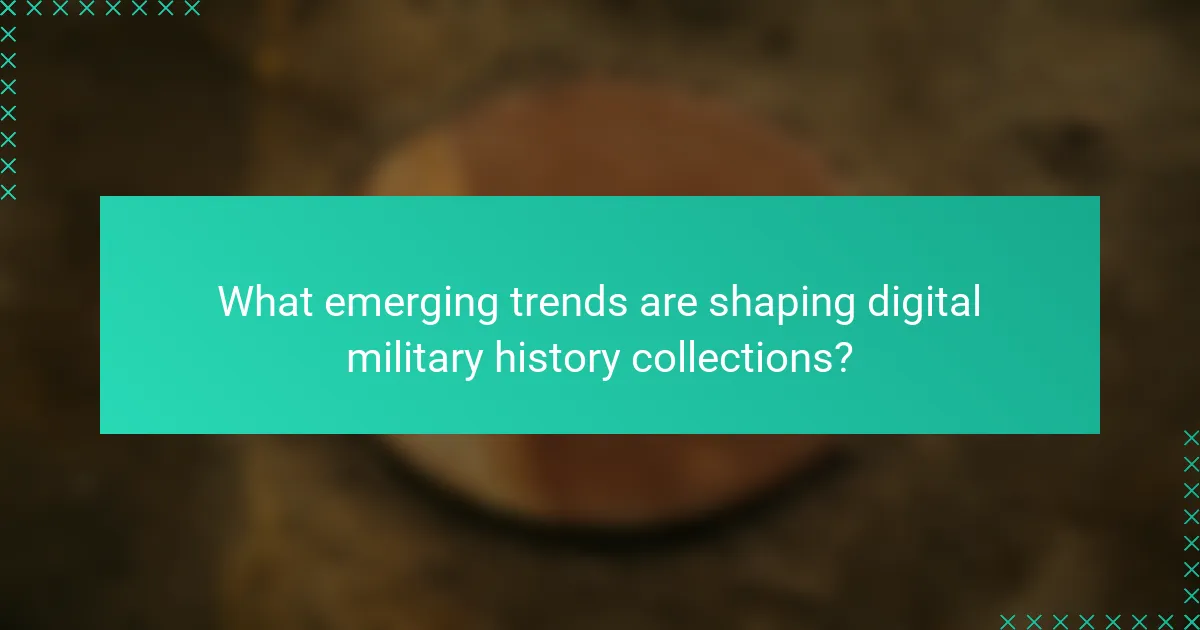
What emerging trends are shaping digital military history collections?
Emerging trends in digital military history collections include the integration of advanced technologies, collaborative efforts among institutions, and the use of immersive experiences. These developments enhance accessibility, engagement, and the overall understanding of military history.
Integration of AI for enhanced search
The integration of artificial intelligence (AI) in digital military history collections significantly improves search capabilities. AI algorithms can analyze vast amounts of data, making it easier for users to find specific documents, images, or artifacts related to military events.
For example, natural language processing allows users to search using everyday language rather than specific keywords, broadening access to information. Institutions should consider implementing AI tools that can learn from user interactions to refine search results continuously.
Increased collaboration among institutions
Collaboration among museums, archives, and educational institutions is on the rise, leading to more comprehensive digital military history collections. By sharing resources and expertise, these entities can create more extensive databases that provide richer narratives and diverse perspectives.
Joint initiatives often result in shared digital platforms, allowing users to explore a wider array of materials. Institutions should actively seek partnerships to enhance their collections and improve user experience through combined efforts.
Expansion of virtual reality experiences
Virtual reality (VR) is becoming an essential tool for engaging users with military history in immersive ways. VR experiences can transport users to historical battlefields or reenact significant events, providing a deeper understanding of the context and impact of military actions.
For effective implementation, institutions should focus on developing high-quality VR content that is accessible to a broad audience. Offering VR experiences in public spaces, such as museums, can attract visitors and enhance educational programs.
